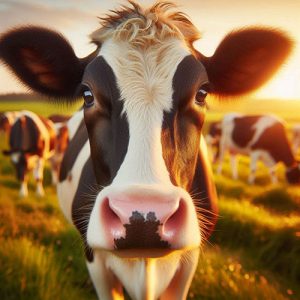rumen protected lysine
Rumen Protected Lysine (RPL) is a specialized nutritional supplement for dairy cows, designed to deliver the essential amino acid lysine directly to the small intestine, bypassing degradation by rumen microbes. Lysine is a first-limiting amino acid in many forage-based dairy diets, crucial for milk protein synthesis (e.g., casein and whey), energy metabolism, immune function, tissue repair, and overall growth. Unprotected lysine sources like are largely broken down in the rumen. RPL overcomes this through encapsulation in a protective coating, achieving over 40% bioavailability and enabling precise amino acid balancing.
The Necessity of Rumen Protected Lysine in Dairy Cow Nutrition and Its Benefits
In modern dairy production, optimizing the nutritional status of cows is essential to maximize milk yield, milk quality, reproductive performance, and overall herd health. Among the key nutrients, amino acids play a pivotal role. Lysine, one of the first‐limiting amino acids in dairy rations, is critical for supporting milk production and maintaining cow health. However, because lysine is highly degradable in the rumen, dairy nutritionists have turned to Rumen Protected Lysine (RPL) as a solution. This article examines why Rumen Protected Lysine is necessary in dairy cow diets, how it works, and the many benefits it confers.
Understanding Amino Acid Requirements in Dairy Cows
Dairy cows require a balanced supply of amino acids for optimal production. Proteins in the diet are broken down by microbes in the rumen into peptides and amino acids; however, not all of these nutrients escape rumen degradation. Lysine is often one of the most limited amino acids, especially in forage-based diets, which tend to be low in this essential nutrient.
Lysine’s role is critical in several physiological processes:
- Milk Protein Synthesis: Lysine is a building block for casein and whey proteins. Adequate lysine availability supports higher milk protein yields.
- Metabolic Functions: Lysine is involved in numerous metabolic pathways, including energy metabolism and tissue repair.
- Immune Function and Growth: As an essential amino acid, lysine helps maintain robust immune function and supports overall body growth and muscle development.
The Challenge of Rumen Degradation
A significant challenge in delivering lysine to dairy cows is its degradation in the rumen. Standard dietary sources such as soybean meal, corn, or blood meal are not fully available to the cow because a large proportion of lysine is broken down by rumen microbes before it reaches the small intestine, where absorption occurs.

Rumen Protected Technology
Rumen Protected Lysine products are specially formulated to encapsulate lysine in a protective coating. This coating is designed to resist degradation by rumen microbes, ensuring that a high percentage of the supplemented lysine passes intact to the small intestine.
The Necessity of Supplementing Rumen Protected Lysine
Economic Efficiency:
By using Rumen Protected Lysine , nutritionists can formulate diets that precisely balance amino acid profiles without overfeeding other protein sources. This not only improves milk production but also enhances feed efficiency and reduces feed costs. A well-balanced amino acid profile helps avoid nutrient wastage, which is important for both economic and environmental reasons.
Precision Nutrition:
Advances in models like the Cornell Net Carbohydrate and Protein System (CNCPS) have made it possible to pinpoint the exact amounts of limiting amino acids required for optimal performance. Dairy nutritionists now incorporate Rumen Protected Lysine to meet these specific needs. With products that offer high bioavailability—often over 40%—the use of RPL ensures that lysine requirements are met even in diets with inherent limitations.
Benefits of Rumen Protected Lysine Supplementation
Enhanced Milk Production and Composition:
Numerous studies and industry reports have shown that supplementing dairy cow diets with RPL can lead to measurable improvements in milk production. For instance:
- Increased Milk Yield: Supplementation has been associated with an increase in daily milk production. Cows receiving RPL often show higher yields compared to those on conventional diets.
- Improved Milk Protein and Fat Content: RPL supplementation helps in synthesizing milk proteins such as casein, resulting in higher milk protein yields. In addition, some research suggests that when combined with other limiting amino acids like methionine, the overall milk fat and protein percentage can be significantly improved. Such improvements not only enhance the nutritional value of milk but also benefit downstream dairy product manufacturing, including cheese production.
Improved Reproductive Health:
Recent studies have extended the benefits of RPL beyond lactation. Research conducted at the University of Illinois found that supplementation of Rumen Protected Lysine during the transition period (the time around calving) can improve uterine health. The study observed a reduction in the expression of inflammatory genes in the uterus, suggesting that RPL can help mitigate the energy diverted to fighting infections postpartum. Improved uterine health may set the stage for better fertility outcomes and a more efficient return to reproductive function after calving.
Better Metabolic Efficiency and Nutrient Utilization:
When cows receive adequate lysine, the overall efficiency of dietary protein utilization improves. This not only supports higher milk production but also reduces the need for excessive dietary protein, thereby decreasing nitrogen waste. Reducing nitrogen excretion is an environmental benefit as it lowers the risk of pollution and improves herd health.
Support During Periods of Nutritional Stress:
Dairy cows may experience periods when forage quality or quantity is limited—for example, during the winter or dry seasons. In these cases, the inclusion of RPL can help maintain optimal amino acid levels despite a lower intake of high-quality protein sources. This support is critical in ensuring that cows continue to perform well under less-than-ideal nutritional conditions.
Cost-Effective Strategy:
In commercial dairy operations, balancing nutrient inputs with economic returns is essential. Rumen Protected Lysine provides a cost-effective strategy to enhance the performance of dairy cows without the need for expensive high-protein feeds. Products from companies such as Purina and Kemin demonstrate that encapsulated lysine sources can yield high bioavailability, meaning that lower doses may be required to achieve the desired nutritional outcome. This efficiency translates into improved gross margins on feed costs.
| lysotech protected lysine |

Synergistic Effects with Other Amino Acids:
The benefits of Rumen Protected Lysine are often maximized when it is combined with other limiting amino acids such as methionine. A balanced lysine-to-methionine ratio is crucial for optimal milk synthesis. Research from Kemin Industries highlights that products designed to deliver both lysine and methionine in the proper ratio can lead to better milk protein quality, enhanced fat synthesis, and overall improved animal performance. Nutritionists are increasingly advocating for a holistic approach to amino acid balancing to support not only lactation but also the overall metabolic health of the cow.
Practical Considerations for Dairy Producers
Diet Formulation:
When incorporating Rumen Protected Lysine into dairy rations, it is important for nutritionists to carefully evaluate the overall amino acid balance of the diet. Modern nutritional models such as CNCPS help in estimating the precise lysine and methionine requirements based on production goals. By using these models, producers can determine the optimal inclusion rate of RPL to meet the needs of their herd.
Product Selection and Quality:
Not all Rumen Protected Lysine products are created equal. Key factors such as the degree of protection, bioavailability, and stability during feed processing are critical
Cost-Benefit Analysis:
The economic benefits of improved milk yield and enhanced milk composition often outweigh the cost of supplementation. Dairy producers are encouraged to conduct cost-benefit analyses when considering feed additives. Enhanced milk fat content, for example, not only boosts farm income but also improves the efficiency of cheese production and other dairy products.
Integration with Overall Herd Management:
Rumen Protected Lysine should be considered part of a broader nutritional strategy that includes other management practices such as proper forage management, body condition scoring, and reproductive health monitoring. By integrating RPL supplementation with overall herd management practices, dairy producers can achieve more consistent performance and improved animal welfare.
Frequently Asked Questions About Rumen Protected Lysine (RPL)
What is rumen-protected lysine (RPL)?
RPL is lysine encapsulated in a coating that protects it from rumen degradation, allowing it to reach the small intestine for better absorption in dairy cows.
Why is lysine important in dairy cow nutrition?
Lysine is a limiting essential amino acid that supports milk protein production, immune health, reproduction, and metabolic functions, especially in forage-heavy diets.
How does RPL differ from unprotected lysine sources?
Unprotected lysine is mostly degraded in the rumen, leading to nutrient loss; RPL ensures higher bioavailability (over 40%) by resisting microbial breakdown.
What are the main benefits of using RPL in dairy rations?
It boosts milk yield and quality (higher protein/fat),
improves fertility, enhances feed efficiency, reduces environmental nitrogen pollution, and lowers overall feed costs.
Can RPL be combined with other amino acids?
Yes, it works synergistically with methionine to optimize amino acid ratios, further improving milk synthesis and metabolic health, as per models like CNCPS.
When should RPL be added to a cow’s diet?
It’s ideal during transition periods (e.g., around calving), low-forage seasons, or when diets are lysine-deficient to maintain performance under stress.
How is rumen-protected lysine produced?
Lysine is coated with rumen-resistant materials to withstand microbial action in the rumen while remaining stable during feed processing and storage.
What is the typical bioavailability of RPL?
High-quality RPL products offer over 40% bioavailability, meaning a significant portion reaches the small intestine intact for absorption.
Does using RPL reduce the need for high-protein feeds?
Yes, by providing targeted lysine, it allows for lower overall protein inclusion, cutting costs and minimizing excess nitrogen excretion.
How can farmers determine the right RPL dosage?
Use nutritional models like CNCPS to assess diet lysine needs based on production goals, then incorporate RPL at rates that balance costs with expected milk yield gains.


